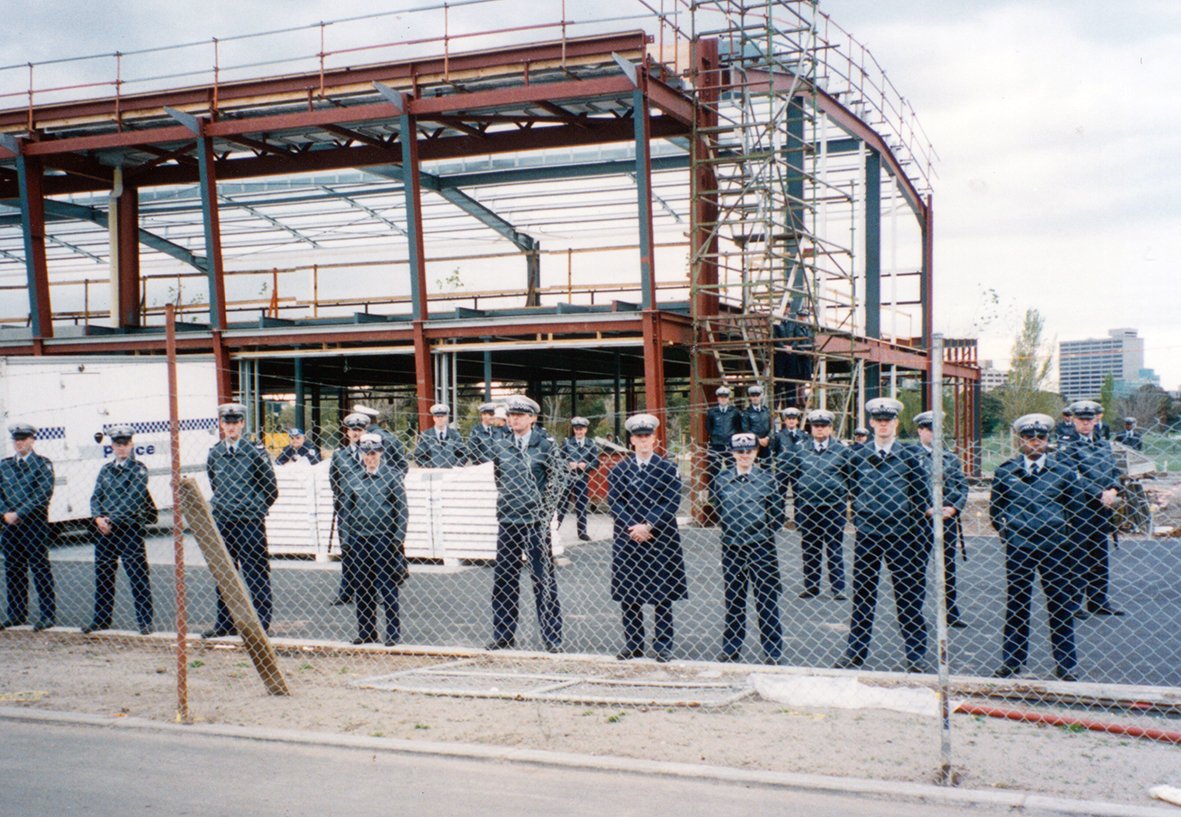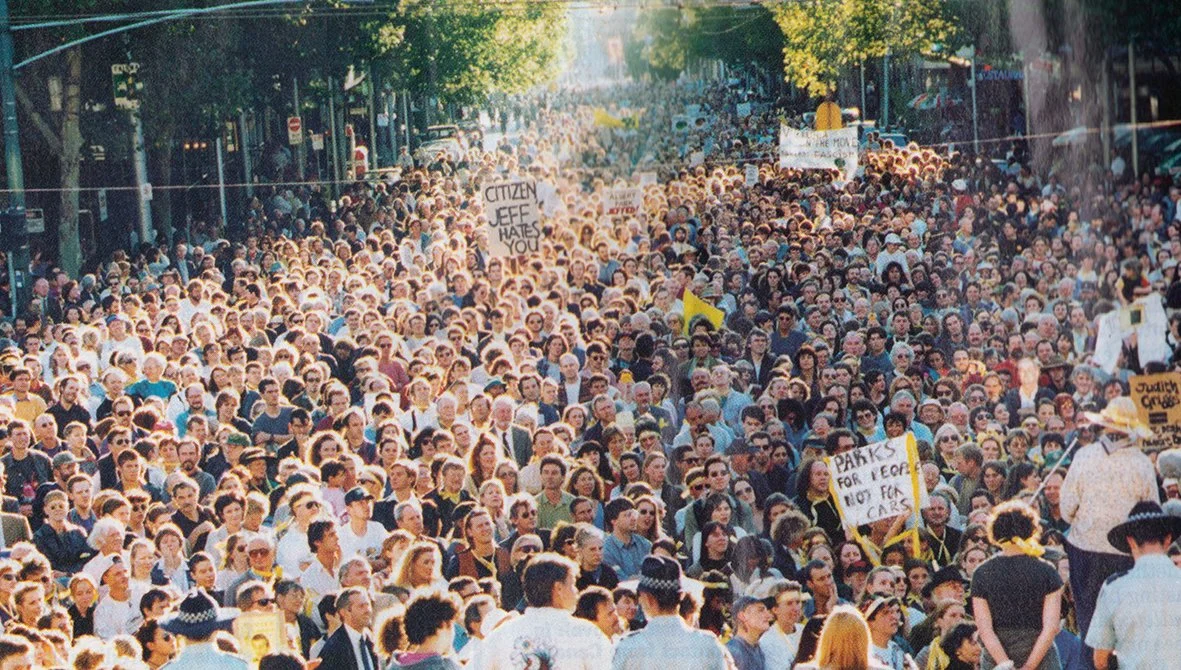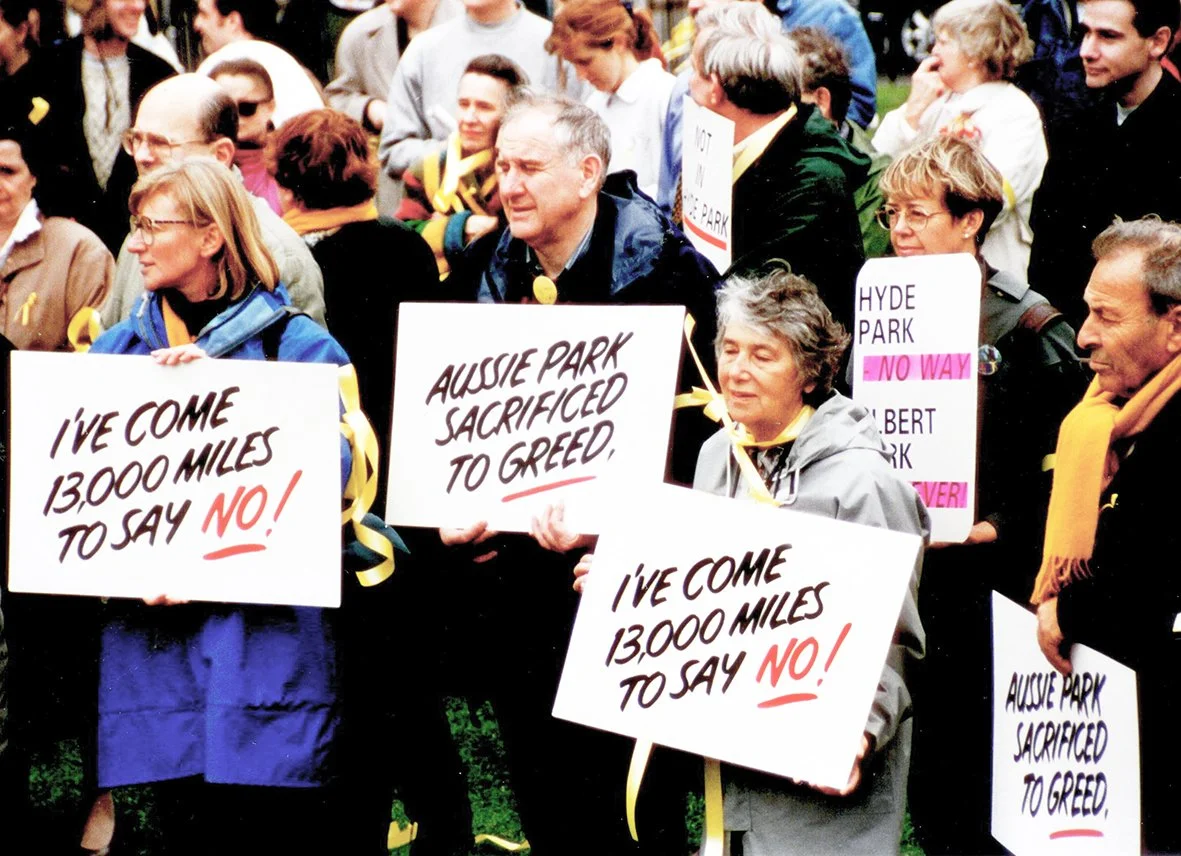BACKGROUND TO THE
ALBERT PARK GRAND PRIX
Artwork: Craig Gough, Save Albert Park
The decision to use Albert Park
The Australian Formula One Grand Prix was run in Adelaide, South Australia, from 1985 to 1995. This event, which was run mainly on Adelaide city streets, was popular and Adelaide expected to renew the contract with Bernie Ecclestone’s London-based Formula One Constructors Association.
In early 1993 the new Kennett Liberal/National Party Government in the State of Victoria, signed a conditional agreement with Ecclestone to hold the race in Melbourne’s Albert Park Reserve from 1996 onwards. This agreement was kept secret from the public and the South Australian Government until its announcement on 17 December 1993. The contract was, and still is, covered by confidentiality clauses and has not been released.
The decision to hold the race was made without any public consultation, environmental impact assessment or detailed government cost-benefit analysis. The decision drew widespread community opposition. Save Albert Park was formed in February 1994 and had thousands of members drawn from across Victoria and Australia.
The Victorian Government refused to consider the many other more cost-effective alternative sites, including the purpose-built Sandown Park motor circuit on the outskirts of Melbourne; Phillip Island, the circuit used for the 500cc motorcycle Grand Prix; or the vacant Docklands site proposed by the Parliamentary Opposition. The Government and the Australian Grand Prix Corporation claimed that the contract with Ecclestone specified that the Melbourne race be held in Albert Park Reserve.
The choice of Albert Park Reserve as the site was opposed by the Australian Conservation Foundation, by all three major opposition parties including the Greens Party, and the Councils of the then two municipalities in which the Park lies.
The Australian Grand Prix Act 1994
In October 1994 the Victorian Government set up the Australian Grand Prix Corporation under legislation (Australian Grand Prix Act 1994) that exempted the event from existing laws governing environmental impact studies, pollution and planning controls. The Act also exempted all agreements with the international promoters from the Freedom of Information Act, and disallowed appeals to the Supreme Court of Victoria
Save Albert Park protests against track works, which commenced in November 1994, resulted in nearly 700 arrests. Most of those arrested were charged merely for being in the Park, which was constituted to be an offence under the Australian Grand Prix Act 1994.
No conviction, however, was ever recorded against any protestor. On 24 May 1995, charges of trespass and other offences against 97 persons were dismissed on the grounds of an “invalid exercise of powers” by the relevant Minister of the Victorian Government. The Victorian Government then passed retrospective legislation to legitimise the invalid exercise of powers and granted an amnesty to those arrested before 25 May 1995.
On 20 December 1995 further charges were dismissed on the grounds that the Australian Grand Prix Corporation did not have a valid power to cordon off any part of the Park in a year when no race was scheduled. In October 1997 further charges were dismissed when the magistrate ruled that the Australian Grand Prix Act did not provide the power to make regulations to exclude demonstrators from a works area.
Construction of the new racetrack required seven weeks of land consolidation works within 200 metres of residential streets. 150 homes were damaged while these works were in progress. Under the Australian Grand Prix Act, no compensation was payable in respect of works undertaken by the Grand Prix Corporation. The Act also amended the Victorian Constitution to prevent the Supreme Court from awarding compensation in relation to anything under the Act.
The Australian Grand Prix Corporation used the Australian Grand Prix Act as its defence in a civil action taken by a resident seeking compensation.
Albert Park Reserve amenities
The 225-hectare (555-acre) Albert Park Reserve was permanently reserved as a public park in 1876. Its lake and what was its most beautiful tree-lined avenue dated from the 1860s.
Its location, 2km from the city centre and adjacent to densely populated inner-city residential suburbs, made it one of the most popular and well-known metropolitan parks in Melbourne.
The Park accommodated a range of sports – rowing and sailing, soccer, Australian Rules football, rugby, hockey, cricket, golf, tennis, baseball – and also an indoor sports and aquatic centre. As well as providing inner-city Melbourne with open space, it included cycling and jogging tracks, children’s playgrounds, picnic areas and was used for shoreline fishing.
The park was used intermittently for motor racing between 1953 and 1958 until the then Government banned future races on the grounds that Albert Park was reserved as a public park for full and free public access.
Upgrade plans prior to Grand Prix announcement
Although the Park had been under-resourced, the responsible government agencies had developed plans for its upgrade. In 1991 “Albert Park: The Vision” was released and in December 1993, the “Draft Strategy Plan”.
Neither document included any suggestion of motor racing and the philosophy of both was implicitly against any such proposal. These reports emphasised the role of the Park as an inner-city haven and recognised the importance of maintaining the historic character of the Park.
“Albert Park: The Vision” also specifically warned against the dangers arising from special events, and specifically recommended:
> reduction in heavy and high-speed traffic on park roads;
> restoration of park roads to their original function as tree-lined park drives;
> increased area of unstructured parkland for multi-purpose recreation; and
> improved visual environment through a tree-planting program and appropriate siting of sports buildings.
Impact of the race on Albert Park Reserve
After government assurances that there would be no permanent Grand Prix structures and only minimal disruption to the Park, both the permanent and temporary impact of the Grand Prix proved to be devastating.
PERMANENT IMPACT
The replacement of the existing park roads by a purpose-build Formula One track and run-offs, required the destruction of more than 1,050 trees, including healthy English Elms, and has led to the die-back of many more. One felled Mahogany Gum was dated to before European settlement in Australia.
The track and provisions for permanent and temporary infrastructure have meant:
> over 50,000m2 of additional asphalt;
> construction of a permanent two-storey pit building, 240m long, 10.6m high and 30m wide;
> restriction of tree-planting to allow construction of temporary grandstands and corporate facilities.
The new park roads built to Formula One requirements have been subject to frequent vehicle accidents and require permanent traffic calming measures.
TEMPORARY IMPACT
All regular park users are denied free access to the Park for the race week. In addition, the massive set-up and dismantling process involves a serious disruption to normal users over a four-month period in the Summer and Autumn.
Set-up works commence three months before the race. Removal of structures takes at least four weeks after each race. The pits, grandstands, VIP parking and hospitality facilities are concentrated in the Sports Precinct section of the park, which contains over 20 sports fields.
Full restoration of the park, including damage to turf surfaces of sports fields and other sections of the park, takes several months after each race. Sporting clubs are forced to relocate to grounds outside the park for training and matches during this period, a disruption that poses a threat to their viability.
Environs of the Park
Albert Park Reserve is situated in one of the most densely populated areas of Melbourne. 30,000 people live within one km of the track, and 114,000 within three km. It represents 60% of the public open space for the 70,000 residents of the local municipality of Port Phillip.
The Park is surrounded by apartments and small block residential housing, village-style shopping centres, small businesses, offices and a variety of community facilities. Situated within 1km of the track are four hospitals, numerous schools, child-care centres and accommodation for the elderly.
The park environs are characterised by congested main roads and lack of off-street parking. The venue requires costly and complex access and parking restrictions and subsidised public transport arrangements to handle attendance over the four-day event.
Under the Australian Grand Prix Act 1994, residents have no legal recourse on grounds of nuisance, or damage to health or property.
The Save Albert Park Campaign
Starting in February 1994 Save Albert Park held many rallies in Melbourne, attracting crowds of up to 20,000, including more than 3,000 who attended a race day protest in March 1996. It conducted a sustained campaign of civil disobedience and community pickets to protest against the construction works. In 1995 it commenced a consumer boycott of major sponsors, in particular Qantas, the naming sponsor. A protest vigil in the Park was maintained from November 1994 until 2004. Volunteers staffed an information office five days a week while others ran a community radio program.
In March 1995 Save Albert Park took the first steps to internationalise the campaign by holding two rallies in London as part of a strategy to have Ecclestone re-negotiate the contract with the Victorian Government and relocate the race to a more appropriate site.
The conversion of an inner-city public park into a temporary motor racing track was, and still is, clearly out of step with international practice for Formula One racing, which is to construct tracks on vacant land well outside population centres.






